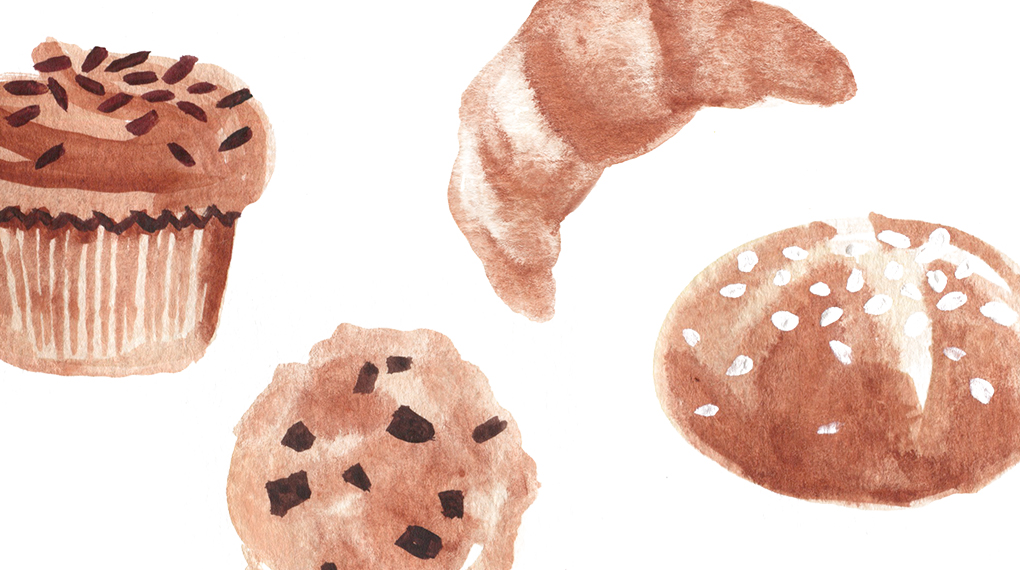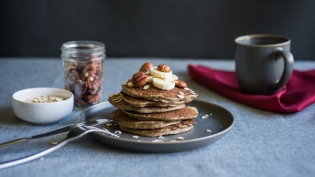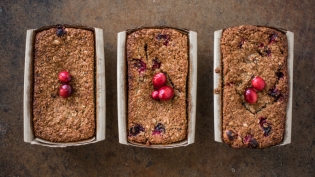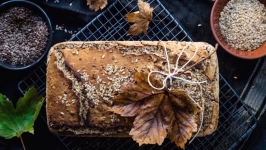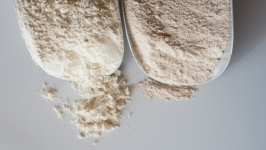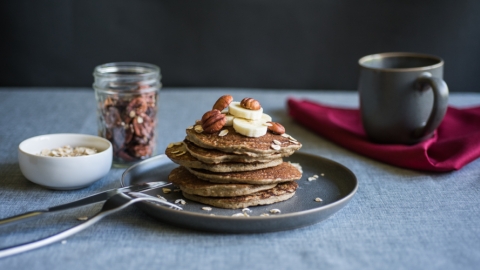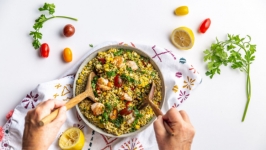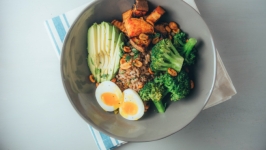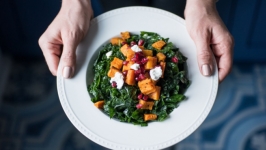Gluten-Free Baking: Fad or Fact of Life?
If you walked into a Jacksonville-area restaurant 10 years ago and asked about the gluten-free menu options, you may have been met with a blank stare from your server and confusion in the kitchen about what exactly you were looking for or trying to avoid. Even today, as gluten-free, vegan, paleo and allergy-friendly diets have become more common, even trendy, it’s not clear if it’s just a fad or a legitimate health issue.
In the last decade, the number of Americans diagnosed with some level of gluten intolerance has skyrocketed from 1 in 2,500 to 1 in 133. Many nutritionists attribute this to the shift in America towards a sugar- and carb-heavy, grab-and-go diet as our lives get increasingly accelerated. When the FDA introduced the original Food Guide Pyramid in 1992, it was weighted heavily towards grains, recommending 6 to 11 servings per day, ideally “whole grains.” This didn’t leave much room for the fresh fruits, vegetables and lean proteins at the top. Wheat flour has become such a staple of our diet in the last two generations, it’s not surprising we would start to see some reaction to a grain that is hard for the human digestive system to break down, especially while it’s being bombarded by so many other stimulants, sugars and food additives.
To understand the offending ingredient, it’s important to know what it is. Gluten is the protein found in wheat, rye and barley. It gives texture and strength to baked goods made with wheat flour and provides the structure for breads and cakes to rise. For people with celiac disease, an autoimmune disorder found in 1 percent of the American population, consuming gluten causes their body to launch an immune attack on the small intestine. The resulting symptoms may include gastric distress, anemia, weight loss, joint pain, muscle cramps, migraines or thyroid and memory problems. With continued consumption of wheat products,malabsorption of nutrients in celiac sufferers can lead to other health problems such as cancer, diabetes and heart disease. It is critical for someone with celiac disease to avoid gluten and wheat containing foods — a particle as little as 20 parts per million will set off this immune response.
It’s also imperative to understand the difference between a food allergy, an immediate hypersensitive immune response to a food protein such as the anaphylaxis common with shellfish or peanut allergies, and a food intolerance, which is a delayed sensitivity that can be caused by the body’s inability to digest a food substance, such as lactose intolerance. Celiac disease is on the extreme end of the food intolerance spectrum. About 3 million Americans are currently living with the disease, which has no cure and is managed solely by diet. Over the last decade, a diagnosis of non-celiac gluten intolerance has become more common. This can mimic some of the symptoms of celiac disease, and may be caused by a lack of digestive enzymes to breakdown the proteins in wheat, rye and barley. Around 18 million Americans have been diagnosed with non-celiac gluten intolerance to date, and the number is climbing rapidly.
The number of Americans following a gluten-free diet has tripled since 2009, whether for fashion or for real health benefits. More people are self-diagnosing and treating gluten intolerance by removing the offending protein from their diet and managing their health themselves, without costly diagnostic tests and the medicines that would be used to treat the symptoms. This sounds like a win-win situation. What harm and what good can possibly come from removing a nonessential nutrient (gluten) and replacing it with more wholesome, less-processed grains?
For Ginny Nehring, the Research and Education Manager for Native Sun, the question hits close to home. Her son was diagnosed with celiac disease in 1998, at 8 years old, after 6 painful years in doctors’ offices trying to find the answer to his health problems. As she said, “Twenty years ago, gluten-free was not a buzzword. It became my mission and passion to learn everything I could about this diet to restore my son’s health.” Nehring took up the challenge first by “cleaning up” her home kitchen to remove all traces of gluten. She was determined to keep her son healthy by feeding the entire family a gluten-free diet, including all desserts. She had to find and develop recipes that would please everyone’s palate, so no one would feel they were missing out.
In the late-1990s, Native Sun was the only store offering anything gluten-free, and it was minimal. Nehring was mail-ordering ingredients, and at the same time, petitioning Native Sun owner Aaron Gottlieb to bring in more products. She would bring him samples of her homemade gluten-free items, and he responded by asking her to come work for him. In 2003, she accepted that offer, and began the process of transitioning Native Sun’s bakery to a completely clean gluten-free facility, which was completed in 2010. “Clean” means there can be no contamination from gluten, which becomes airborne in flour and can pose a threat to someone with celiac disease even in that small quantity (20 ppm, which Nehring refers to as the proverbial “crumb in the butter”). As of 2017, while several local bakeries and restaurants offer gluten-free menu options, including desserts, Native Sun’s bakery remains the only dedicated gluten-free facility.
Nehring expressed concern about the popularity of gluten-free options hurting celiac sufferers, who may have a false sense of security about the precautions chefs and bakers are taking in their preparations of gluten-free menu items. There is not a standardized certification that manufacturers or even small scale bakers need in order to label their products gluten-free. If it’s a lifestyle choice and not a medical concern, those options may be completely safe. However, it’s important for chefs to be aware and educate their staff and customers that within a kitchen serving foods containing wheat and gluten, there is still the potential for a celiac sufferer to get sick through cross-contamination.
When Dr. William Davis’ “Wheat Belly” hit the bestseller list within a week of publication in 2011, it really kickstarted the trend to eliminate wheat and excess grains from the diet. The benefits advocated were weight loss, increased energy and mental clarity. Dr. Davis cites the changes in modern agriculture that have altered the structure and digestibility of wheat proteins, just within the last 50 years. We are not eating the same wheat our grandparents did, and if you look back just a few generations more, you will see that most of our ancestors weren’t eating wheat at all! Modern wheat is bred for high yield and low nutritional content. The pesticides used to manage its growth may remain within the grain and could contribute to the toxic overload on our environmental and bodily systems.
Is gluten more trouble than it’s worth to continue consuming? With our penchant for sweet rewards and desserts, there’s a slim chance we’ll give up those treats any time soon. As a result, we see the rise of gluten-free pastries, which are a challenge to perfect, but also a necessity for those with celiac disease and gluten sensitivities if they want to continue enjoying those celebratory foods along with family and friends.
Anyone who has tried their hand at baking can attest there is a scientific method to following a recipe and getting consistent results. Baked goods require a delicate balance of protein, liquid, fat and leavening to rise and set properly when placed in the oven. For traditional cakes made with wheat flour, the gluten builds the scaffolding for the egg and baking powder or soda to achieve their maximum height. In breads, the higher gluten of a hard wheat flour gives the yeast legs to climb. These gluten-dependent reactions create the familiar tenderness in cakes and chewiness in breads and pizza dough that we crave. When gluten is removed, different laws are in effect. There are principles of substitution that need to be applied. Gluten-free pastries often require more baking powder to rise and more liquid to compensate for heavier, absorbent flours like potato and rice flour. Starches, such as corn or potato, need to be added to a gluten-free flour blend to replace some of the elasticity of gluten, and gums (xantham, guar) are used to stand in for the structure the gluten would provide.
Successful gluten-free baking entails much trial and error, especially if trying to recreate a beloved recipe without the gluten. Whether your mom baked from scratch or used a cake mix, you likely have an idealized version of your favorite treat based on decades of bakers perfecting formulas with wheat flour. It is what we grew up on — what we’ve come to expect. And that creates a great challenge for bakers trying to give us the same sensory satisfaction with alternative flours that may carry different flavors and textures on our tongues. In the last 5 years, gluten-free flour blends have become widely available and can be found in most grocery stores. Most of these blends make an excellent substitute for all-purpose wheat. Bread doughs are more challenging because of the higher protein and structure required when working with yeast, but commercially available gluten-free breads are improving.
Ginny Nehring loves the challenge of gluten-free baking, and her labor of love has driven her to create exceptional baked goods with alternative flours. She expressed that the most insulting thing you can say to her is, “This tastes good… for gluten-free.” Her passion is to “make people that need a gluten-free diet understand that life doesn’t have to change — that you don’t have to go without. You can still eat that cake or pie and celebrate with everyone else.” I think she best sums up the challenge and the reward of creating delectable gluten-free treats. “Food is social. I never want anyone to feel excluded, especially by something as wonderful as dessert."


